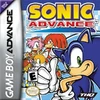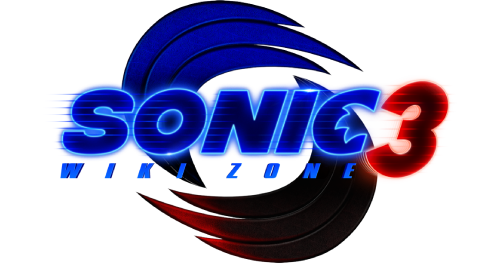Information in this article is about real-life people, companies, and objects, which do not relate to the in-universe Sonic series. |
The Nintendo DS, officially known as the Nintendo Developers' System[10] and also referred to as the Nintendo Dual-Screen[10] or NDS, is a handheld game system developed and manufactured by Nintendo. It has two screens; the top screen being for viewing only, while the lower screen can be used as a touchscreen interface.
The first two iterations of the system, the standard Nintendo DS and DS Lite are also able to play Game Boy Advance titles, which can be displayed on any screen, however the screen it is displayed on must be changed in the Options; by default, it is the top screen. However, Game Boy and Game Boy Color games cannot be played. The third and fourth iterations, the Nintendo DSi, and DSi XL are unable to play Game Boy Advance titles due to the removal of the GBA cartridge slot. Its successor is the Nintendo 3DS, which is backward compatible with DS and DSi titles.
The Sonic the Hedgehog series made its debut on the Nintendo DS with the critically acclaimed Sonic Rush. The final game of the series on the platform was Sonic Colors.
Sonic games[]
Nintendo DS Games[]
 Sonic Rush (2005) |
 Sonic Rush Adventure (2007) |
 Mario & Sonic at the Olympic Games (2008) |
 Sega Superstars Tennis (2008) |
 Sonic Chronicles: The Dark Brotherhood (2008) |
 Mario & Sonic at the Olympic Winter Games (2009) |
 Sonic & Sega All-Stars Racing (2010) |
 Sonic Classic Collection (2010) |
 Sonic Colors (2010) |
Game Boy Advance Games[]
- Sonic games

|

|

|
| Sonic Advance (2001) | Sonic Advance 2 (2002) | Sonic Battle (2003) |

|

|

|
| Sonic Pinball Party (2003) | Sonic Advance 3 (2004) | Sonic the Hedgehog Genesis (2006) |
- Compilations
- Sonic X videocarts

|

|
| Sonic X: A Super Sonic Hero | Sonic X: Chaos Emerald Chaos (unreleased) |
Characters introduced[]

Sonic playing Sonic Rush Adventure on a DS Lite.
Hardware[]
The Nintendo DS features a clamshell design, much like the Game Boy Advance SP, and has an integrated sleep function, allowing the user to close the system to save battery and re-open it to resume playing. The stylus is located on the top right of the system's back, near the R Button, while the charger port is on the left, near the L Button. The DS uses the same charger as the Game Boy Advance SP. Unlike the GBA SP, the DS has its own built-in headphone jack, located at the bottom right of the system. The SP's Headphone Adapter is still supported by the DS. The power button is located above the D-pad, and the Select and Start buttons are located above the four face buttons. The DS supports wireless features, allowing users to connect their system to other systems locally or to the Internet without the use of cables.
The DS Game Card slot (Slot-1) is located at the top, behind the system. While the user can still eject Game Cards by pulling them out, it is preferable to push onto the card, which then springs it upwards. The Game Boy Advance slot (Slot-2) is located at the bottom of the system and does not use the same mechanism for ejecting games as the Game Card slot does; the user must still pull them out. Slot-2 has other purposes beyond GBA support; it has also been used for a number of accessories, such as the Rumble Pak and the Memory Expansion Pak. The DS does not allow its wireless features to work with GBA titles, and does not allow for Link Cables or the Game Boy Advance Wireless Adapter to be connected to the system, only allowing for single-player experiences.
Revisions[]
DS Lite[]
In mid 2006, Nintendo released the Nintendo DS Lite, a slimmer revision of the Nintendo DS. This model adds adjustable backlit screens, allowing the user to select between four different brightness settings, compared to the original model's frontlit screens with two brightness settings. Game Boy Advance cartridges protrude a bit more, instead of sitting flush with the system. The DS Lite used a different charger connector, meaning the connector used on the Game Boy Advance SP and the original DS is not compatible.
Trivia[]
- Both Sonic the Hedgehog Genesis and Sonic Classic Collection are playable on both the DS and DS Lite systems, for the original Sonic the Hedgehog.
- There was a Sonic game planned for the DS, titled Sonic DS, which was later scrapped.
- The Nintendo DS is the only Nintendo handheld to not have its games re-released under a budget label (Player's Choice/Nintendo Selects).
- The Nintendo DS, alongside the Wii, PlayStation 3 and Xbox 360, are the only consoles in which all three voice actor casts are featured; the original Dreamcast ones, the 4Kids ones and the Studiopolis ones.
- If a user plugs a Game Boy Advance SP Headphone Adapter into the original Nintendo DS' charger port, they can use both the adapter's headphone jack and the built-in headphone jack simultaneously.
References[]
- ↑ Gantayat, Anoop (7 October 2004). IGN: NDS Japanese Launch Details. IGN.
- ↑ 2.0 2.1 Harris, Craig (20 September 2004). Official Nintendo DS Launch Details. IGN. Retrieved on 2 August 2018.
- ↑ 3.0 3.1 3.2 Fahey, Rob (28 February 2005). Nintendo claims most successful launch ever for DS in Australia.
- ↑ ゲームハードの初期価格 (Japanese). Geocities Japan (11 November 2006). Archived from the original on 5 June 2009. Retrieved on 2 August 2018.
- ↑ CESA staff (July 2016). "11" (in Japanese). CESAゲーム白書. CESA. p. 175. ISBN 978-4902346343.
- ↑ 6.0 6.1 Consolidated Sales Transition by Region (PDF). Nintendo (27 April 2016). Retrieved on 9 April 2018.
- ↑ 7.0 7.1 7.2 7.3 Redge, David (11 March 2004). Nintendo DS specs are leaked. DarkZero. Archived from the original on 25 September 2020. Retrieved on 25 September 2020.
- ↑ Robertson, Andy (18 September 2012). The (Nearly) Definitive Nintendo Battery Test. Wired. Retrieved on 6 March 2018.
- ↑ Sklens, Mike (24 October 2004). Nintendo Tells Players 'Touching is Good'. Nintendo World Report. Archived from the original on 25 September 2020. Retrieved on 25 September 2020.
- ↑ 10.0 10.1 Nintendo . What Does "DS Stand For?. Nintendo Support. Retrieved on 2 August 2018. "To our developers, it stands for "Developers' System," since we believe it gives game creators brand new tools which will lead to more innovative games for the world's players. It can also stand for "Dual Screen""
| Sega | Home consoles | Sega Master System · Sega Mega Drive (Toshokan, Sega CD, Sega 32X, Mini, Mini 2) · Sega Saturn · Dreamcast |
| Handheld consoles | Sega Game Gear · Sega Mega Jet · Sega Nomad · Sega Pico · Coleco Sonic · Game Gear Micro | |
| Mobile | Sonic Cafe · Sega Mobile · Puyo Puyo! Sega | |
| Browser | PlaySega | |
| Nintendo | Home consoles | Nintendo GameCube · Wii · Wii U |
| Handheld consoles | Game Boy Advance · Nintendo DS · Nintendo 3DS | |
| Hybrids | Nintendo Switch | |
| Microsoft | Xbox · Xbox 360 · Xbox One · Xbox Series X and Series S | |
| Sony | Home consoles | PlayStation 2 · PlayStation 3 · PlayStation 4 · PlayStation 5 |
| Handheld consoles | PlayStation Portable · PlayStation Vita | |
| Mobile systems | iOS/iPad OS (Apple Arcade) · Android · Windows Phone | |
| Other | Arcade · Ouya · PC (Steam, Epic Games) | |







